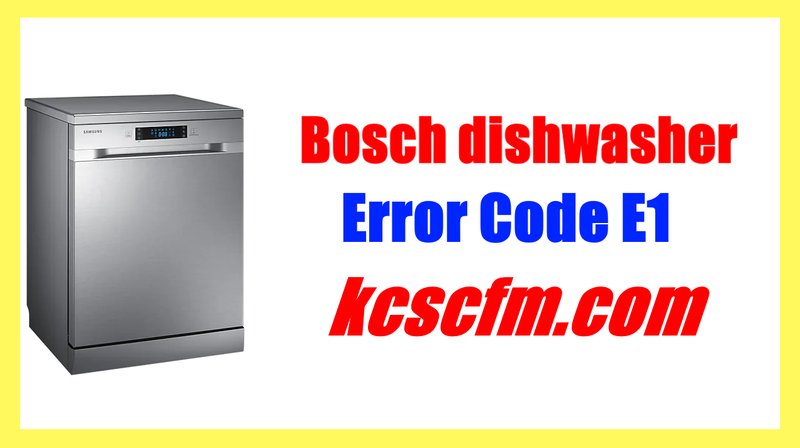
Error Code E1 generally indicates a problem with the water supply, specifically related to the dishwasher’s ability to fill with water efficiently. Think of it this way: your dishwasher is like a bathtub that doesn’t quite fill up because there’s not enough water being let in or because it’s draining out too quickly. Understanding the root of this problem is key to resolving it, and fortunately, many of the causes can be fixed without calling in an expensive repair technician.
Understanding the Basics of Error Code E1
When your Bosch dishwasher displays Error Code E1, it’s sending a signal that something is amiss with the water supply process. This code is essentially the machine’s way of alerting us that it can’t complete its washing cycle because there’s a hiccup somewhere in how it receives or retains water. It’s like when you’re trying to fill a water bottle and the faucet doesn’t open fully — either the flow is too slow, or there’s an obstruction.
So why is water so crucial? Water plays a vital role in every dishwasher cycle because it dissolves the detergent, sprays away food particles, and rinses the dishes clean. Without the right amount of water at the right points, your dishes won’t get the clean they need. The machine, sensing this, stops and flags the error to prevent wasting energy or risking damage.
Here’s the deal: Although the Error Code E1 might sound technical, the underlying causes are often related to straightforward issues such as the water inlet valve, drain hose, or even the water tap. By addressing these common areas of concern, you might be able to resolve the issue on your own.
Exploring the Common Causes
First up, let’s discuss the water inlet valve. This component is like your dishwasher’s gatekeeper for water — it allows the right amount of water to enter during the wash cycle. If it’s defective or clogged, water may trickle in too slowly or not at all. Picture a garden hose that’s pinched somewhere along its length; the water might trickle but it’s not enough to water your garden effectively.
Another typical culprit is the drain hose. Imagine trying to fill a bucket with a hole in the bottom — water will escape as quickly as it arrives. If your dishwasher’s drain hose is improperly installed or damaged, it could be allowing water to siphon out when it should be staying put, causing the machine to think there’s a water shortage.
Then, there’s the issue of the water tap itself. If the valve that’s supposed to supply water to your dishwasher isn’t fully open, or if the water line is kinked or clogged, this can prevent adequate water flow from reaching your appliance. It’s as if someone is only slightly opening the faucet in your kitchen sink — you wouldn’t be able to fill a pot quickly, if at all!
So, where do you go from here? Start by checking these components. Ensure the water tap is fully open, inspect the inlet valve for blockages, and make sure the drain hose isn’t crimped or damaged. These initial checks might save you a service call and get your dishwasher back on track.
Steps For Troubleshooting and Fixes
You might be wondering, “How exactly do I troubleshoot these issues?” Don’t worry; I’ve got you covered. Let’s break it down step by step.
Firstly, examine the water tap that supplies your dishwasher. Make sure it’s turned on fully. It might sound obvious, but sometimes the handle can be nudged partially closed, restricting flow. If the valve is open yet no water seems to flow, there might be a blockage further up the line.
Next, check the water inlet valve. You’ll typically find this at the bottom front of your dishwasher. If you’re comfortable, carefully detach the valve and inspect the mesh filter inside for clogs. Cleaning out any debris could solve the problem. If the valve itself seems faulty, consider replacing it.
Lastly, inspect the drain hose. Make sure it’s positioned correctly — not too high or low — to ensure proper water retention. Look for kinks or damage, and make sure the connection to the sink drain or disposal unit is secure.
If these steps don’t fix the issue, it may be wise to consult the user manual or contact a professional. Still, having checked these common trouble points, you’ll be better informed when discussing the problem with a technician.
Preventative Measures and Final Thoughts
Once your dishwasher is back in working order, how can you prevent Error Code E1 from returning? Regular maintenance is key. Periodically check the water inlet valve and clean its filter to prevent blockages. You should also ensure the drain hose remains in good condition and properly positioned.
Another tip: Running your dishwasher regularly can help. Sometimes infrequent use leads to sediment build-up or drying out of seals, which can exacerbate minor issues. Think of it like keeping a car running smoothly; regular use and maintenance prevent bigger problems down the line.
In conclusion, while the appearance of Error Code E1 can initially cause alarm, understanding the basic mechanics behind it demystifies the issue. With a little patience and basic troubleshooting, you might find these common problems are easily fixable. So next time your Bosch dishwasher flashes that E1 at you, you’ll be ready to tackle it with confidence.